technical specifications Alfa Romeo Brera/Spider 2008 Owner handbook (in English)
[x] Cancel search | Manufacturer: ALFA ROMEO, Model Year: 2008, Model line: Brera/Spider, Model: Alfa Romeo Brera/Spider 2008Pages: 270, PDF Size: 3.93 MB
Page 66 of 270
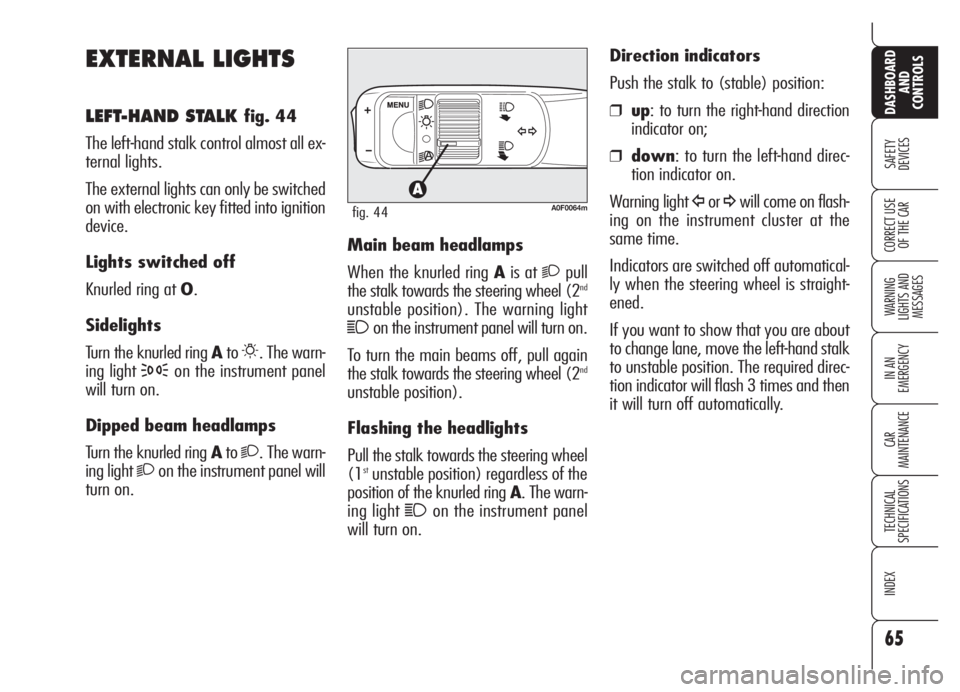
65
SAFETY
DEVICES
WARNING
LIGHTS AND
MESSAGES
IN AN
EMERGENCY
CAR
MAINTENANCE
TECHNICAL
SPECIFICATIONS
INDEX
DASHBOARD
AND
CONTROLS
CORRECT USE
OF THE CAR
EXTERNAL LIGHTS
LEFT-HAND STALK fig. 44
The left-hand stalk control almost all ex-
ternal lights.
The external lights can only be switched
on with electronic key fitted into ignition
device.
Lights switched off
Knurled ring at O.
Sidelights
Turn the knurled ring Ato
6. The warn-
ing light
3on the instrument panel
will turn on.
Dipped beam headlamps
Turn the knurled ring Ato
2. The warn-
ing light
2on the instrument panel will
turn on.Main beam headlamps
When the knurled ring Ais at
2pull
the stalk towards the steering wheel (2nd
unstable position). The warning light
1on the instrument panel will turn on.
To turn the main beams off, pull again
the stalk towards the steering wheel (2
nd
unstable position).
Flashing the headlights
Pull the stalk towards the steering wheel
(1
stunstable position) regardless of the
position of the knurled ring A. The warn-
ing light
1on the instrument panel
will turn on.Direction indicators
Push the stalk to (stable) position:
❒up: to turn the right-hand direction
indicator on;
❒down: to turn the left-hand direc-
tion indicator on.
Warning light
Îor¥will come on flash-
ing on the instrument cluster at the
same time.
Indicators are switched off automatical-
ly when the steering wheel is straight-
ened.
If you want to show that you are about
to change lane, move the left-hand stalk
to unstable position. The required direc-
tion indicator will flash 3 times and then
it will turn off automatically.A0F0064mfig. 44
Page 67 of 270
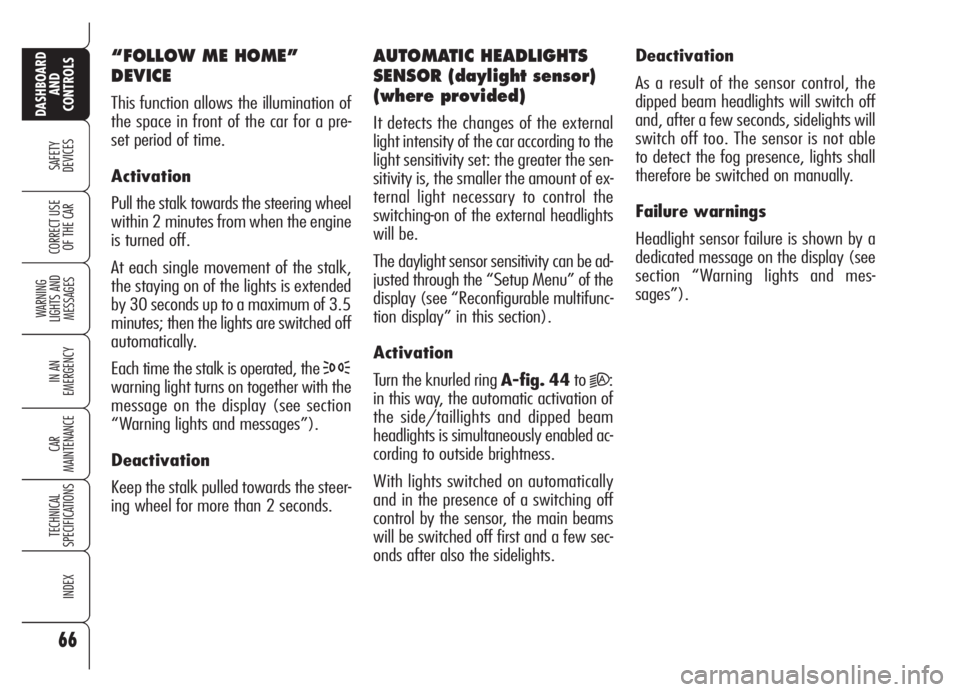
66
SAFETY
DEVICES
WARNING
LIGHTS AND
MESSAGES
IN AN
EMERGENCY
CAR
MAINTENANCE
TECHNICAL
SPECIFICATIONS
INDEX
DASHBOARD
AND
CONTROLS
CORRECT USE
OF THE CAR
“FOLLOW ME HOME”
DEVICE
This function allows the illumination of
the space in front of the car for a pre-
set period of time.
Activation
Pull the stalk towards the steering wheel
within 2 minutes from when the engine
is turned off.
At each single movement of the stalk,
the staying on of the lights is extended
by 30 seconds up to a maximum of 3.5
minutes; then the lights are switched off
automatically.
Each time the stalk is operated, the
3
warning light turns on together with the
message on the display (see section
“Warning lights and messages”).
Deactivation
Keep the stalk pulled towards the steer-
ing wheel for more than 2 seconds.
AUTOMATIC HEADLIGHTS
SENSOR (daylight sensor)
(where provided)
It detects the changes of the external
light intensity of the car according to the
light sensitivity set: the greater the sen-
sitivity is, the smaller the amount of ex-
ternal light necessary to control the
switching-on of the external headlights
will be.
The daylight sensor sensitivity can be ad-
justed through the “Setup Menu” of the
display (see “Reconfigurable multifunc-
tion display” in this section).
Activation
Turn the knurled ring A-fig. 44to
2A:
in this way, the automatic activation of
the side/taillights and dipped beam
headlights is simultaneously enabled ac-
cording to outside brightness.
With lights switched on automatically
and in the presence of a switching off
control by the sensor, the main beams
will be switched off first and a few sec-
onds after also the sidelights.Deactivation
As a result of the sensor control, the
dipped beam headlights will switch off
and, after a few seconds, sidelights will
switch off too. The sensor is not able
to detect the fog presence, lights shall
therefore be switched on manually.
Failure warnings
Headlight sensor failure is shown by a
dedicated message on the display (see
section “Warning lights and mes-
sages”).
Page 68 of 270
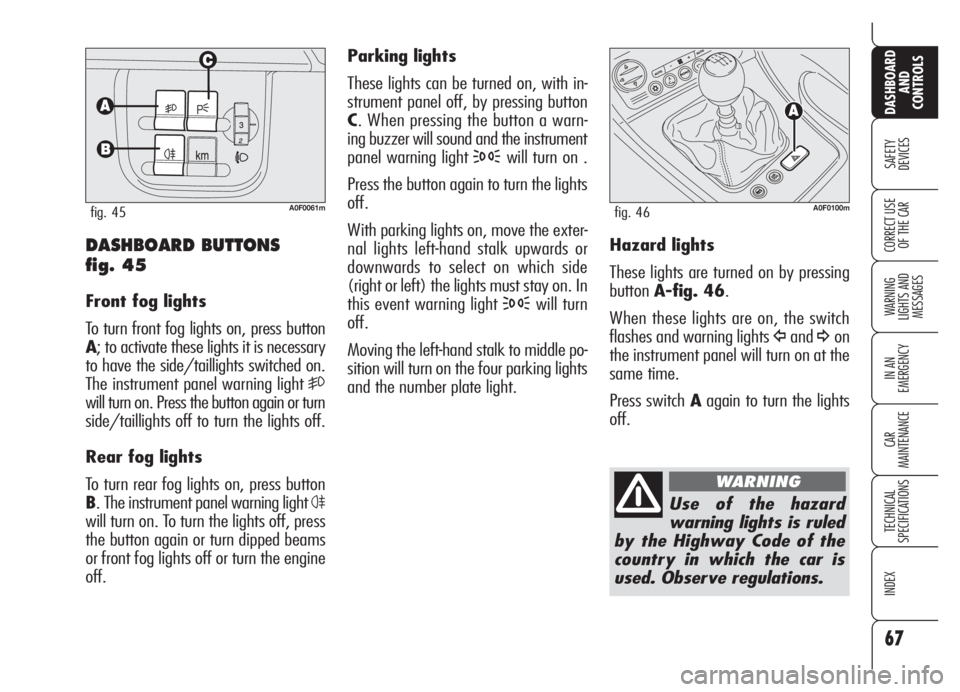
67
SAFETY
DEVICES
WARNING
LIGHTS AND
MESSAGES
IN AN
EMERGENCY
CAR
MAINTENANCE
TECHNICAL
SPECIFICATIONS
INDEX
DASHBOARD
AND
CONTROLS
CORRECT USE
OF THE CAR
Parking lights
These lights can be turned on, with in-
strument panel off, by pressing button
C. When pressing the button a warn-
ing buzzer will sound and the instrument
panel warning light
3will turn on .
Press the button again to turn the lights
off.
With parking lights on, move the exter-
nal lights left-hand stalk upwards or
downwards to select on which side
(right or left) the lights must stay on. In
this event warning light
3will turn
off.
Moving the left-hand stalk to middle po-
sition will turn on the four parking lights
and the number plate light.
DASHBOARD BUTTONS
fig. 45
Front fog lights
To turn front fog lights on, press button
A; to activate these lights it is necessary
to have the side/taillights switched on.
The instrument panel warning light
5
will turn on. Press the button again or turn
side/taillights off to turn the lights off.
Rear fog lights
To turn rear fog lights on, press button
B. The instrument panel warning light
4
will turn on. To turn the lights off, press
the button again or turn dipped beams
or front fog lights off or turn the engine
off.
A0F0061mfig. 45
Hazard lights
These lights are turned on by pressing
buttonA-fig. 46.
When these lights are on, the switch
flashes and warning lights
Îand¥on
the instrument panel will turn on at the
same time.
Press switch Aagain to turn the lights
off.
Use of the hazard
warning lights is ruled
by the Highway Code of the
country in which the car is
used. Observe regulations.
WARNING
A0F0100mfig. 46
Page 69 of 270
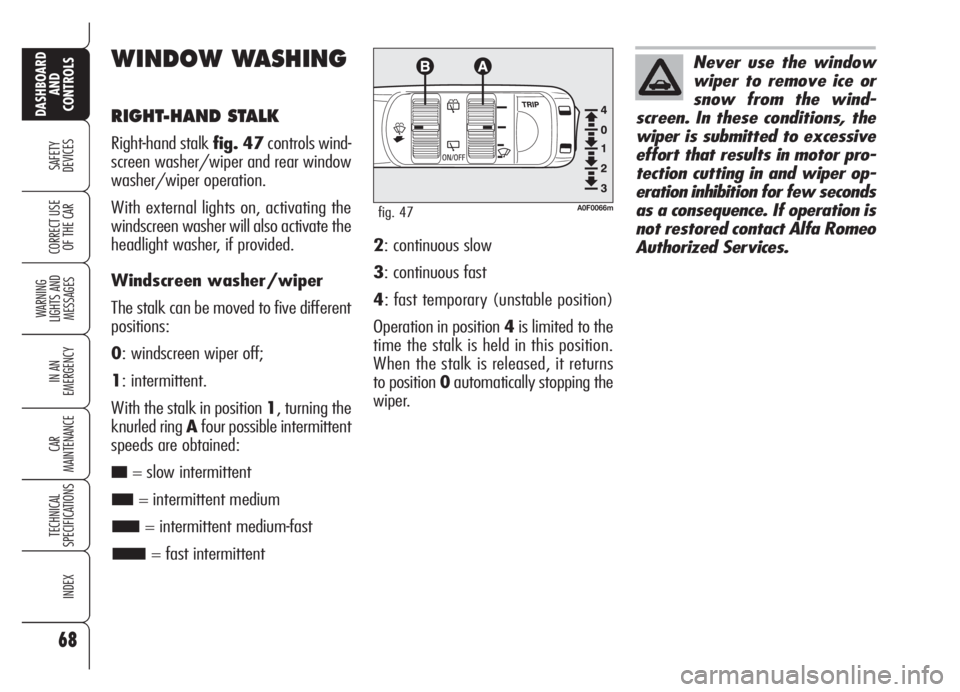
68
SAFETY
DEVICES
WARNING
LIGHTS AND
MESSAGES
IN AN
EMERGENCY
CAR
MAINTENANCE
TECHNICAL
SPECIFICATIONS
INDEX
DASHBOARD
AND
CONTROLS
CORRECT USE
OF THE CAR
WINDOW WASHING
RIGHT-HAND STALK
Right-hand stalk fig. 47controls wind-
screen washer/wiper and rear window
washer/wiper operation.
With external lights on, activating the
windscreen washer will also activate the
headlight washer, if provided.
Windscreen washer/wiper
The stalk can be moved to five different
positions:
0: windscreen wiper off;
1: intermittent.
With the stalk in position 1, turning the
knurled ring Afour possible intermittent
speeds are obtained:
■= slow intermittent
■= intermittent medium
■= intermittent medium-fast
■= fast intermittent2: continuous slow
3: continuous fast
4: fast temporary (unstable position)
Operation in position 4is limited to the
time the stalk is held in this position.
When the stalk is released, it returns
to position 0automatically stopping the
wiper.
A0F0066mfig. 47
Never use the window
wiper to remove ice or
snow from the wind-
screen. In these conditions, the
wiper is submitted to excessive
effort that results in motor pro-
tection cutting in and wiper op-
eration inhibition for few seconds
as a consequence. If operation is
not restored contact Alfa Romeo
Authorized Services.
Page 70 of 270
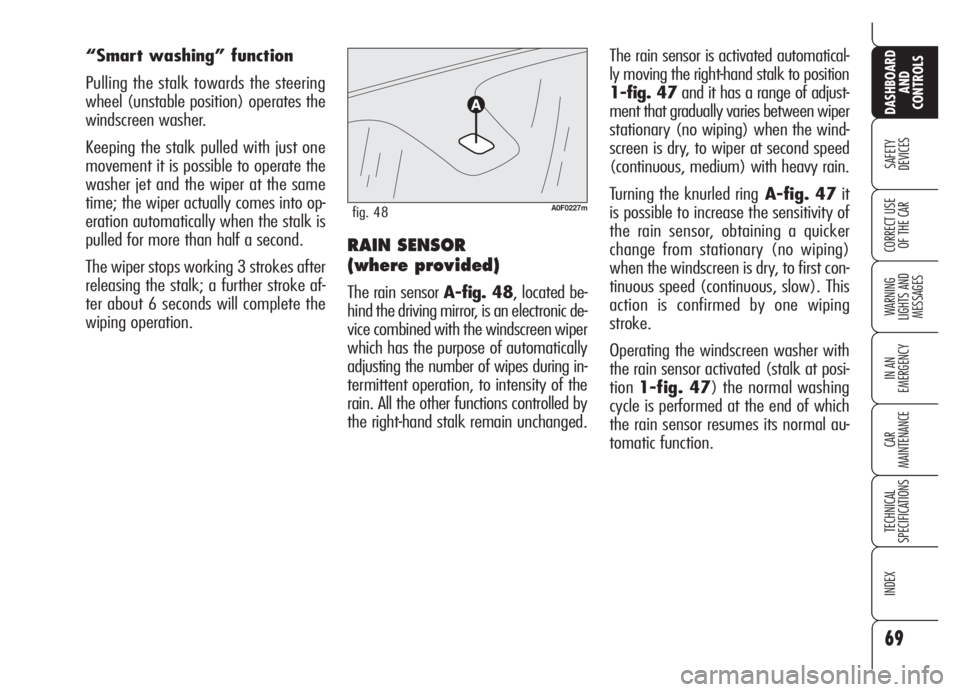
69
SAFETY
DEVICES
WARNING
LIGHTS AND
MESSAGES
IN AN
EMERGENCY
CAR
MAINTENANCE
TECHNICAL
SPECIFICATIONS
INDEX
DASHBOARD
AND
CONTROLS
CORRECT USE
OF THE CAR
The rain sensor is activated automatical-
ly moving the right-hand stalk to position
1-fig. 47and it has a range of adjust-
ment that gradually varies between wiper
stationary (no wiping) when the wind-
screen is dry, to wiper at second speed
(continuous, medium) with heavy rain.
Turning the knurled ringA-fig. 47it
is possible to increase the sensitivity of
the rain sensor, obtaining a quicker
change from stationary (no wiping)
when the windscreen is dry, to first con-
tinuous speed (continuous, slow). This
action is confirmed by one wiping
stroke.
Operating the windscreen washer with
the rain sensor activated (stalk at posi-
tion1-fig. 47) the normal washing
cycle is performed at the end of which
the rain sensor resumes its normal au-
tomatic function. “Smart washing” function
Pulling the stalk towards the steering
wheel (unstable position) operates the
windscreen washer.
Keeping the stalk pulled with just one
movement it is possible to operate the
washer jet and the wiper at the same
time; the wiper actually comes into op-
eration automatically when the stalk is
pulled for more than half a second.
The wiper stops working 3 strokes after
releasing the stalk; a further stroke af-
ter about 6 seconds will complete the
wiping operation.
RAIN SENSOR
(where provided)
The rain sensor A-fig. 48, located be-
hind the driving mirror, is an electronic de-
vice combined with the windscreen wiper
which has the purpose of automatically
adjusting the number of wipes during in-
termittent operation, to intensity of the
rain. All the other functions controlled by
the right-hand stalk remain unchanged.
A0F0227mfig. 48
Page 71 of 270
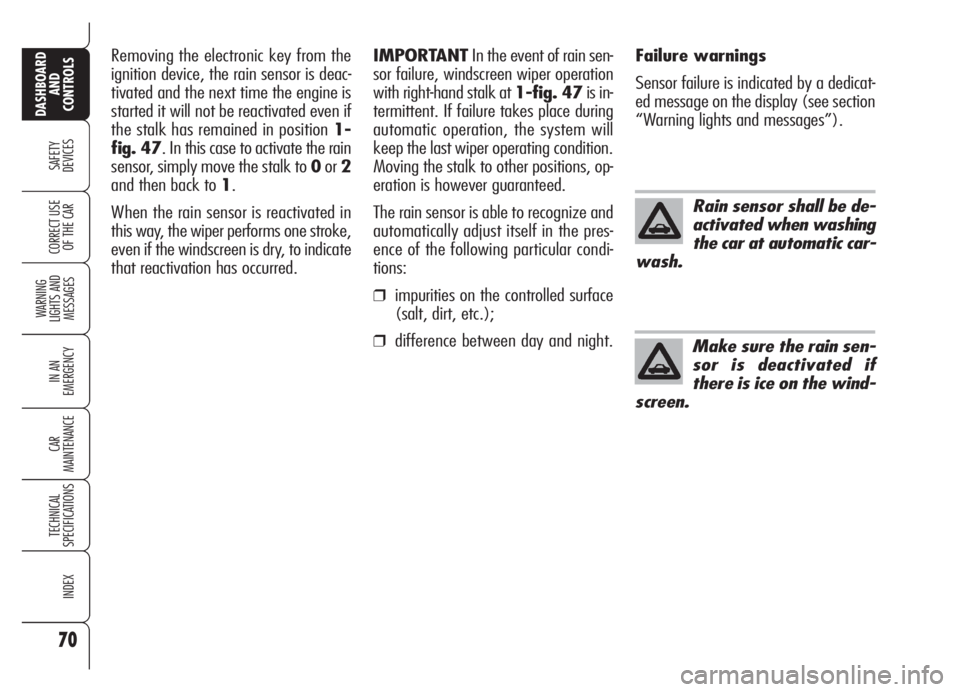
70
SAFETY
DEVICES
WARNING
LIGHTS AND
MESSAGES
IN AN
EMERGENCY
CAR
MAINTENANCE
TECHNICAL
SPECIFICATIONS
INDEX
DASHBOARD
AND
CONTROLS
CORRECT USE
OF THE CAR
Rain sensor shall be de-
activated when washing
the car at automatic car-
wash.
Make sure the rain sen-
sor is deactivated if
there is ice on the wind-
screen.
Removing the electronic key from the
ignition device, the rain sensor is deac-
tivated and the next time the engine is
started it will not be reactivated even if
the stalk has remained in position 1-
fig. 47. In this case to activate the rain
sensor, simply move the stalk to 0or2
and then back to 1.
When the rain sensor is reactivated in
this way, the wiper performs one stroke,
even if the windscreen is dry, to indicate
that reactivation has occurred.IMPORTANTIn the event of rain sen-
sor failure, windscreen wiper operation
with right-hand stalk at 1-fig. 47is in-
termittent. If failure takes place during
automatic operation, the system will
keep the last wiper operating condition.
Moving the stalk to other positions, op-
eration is however guaranteed.
The rain sensor is able to recognize and
automatically adjust itself in the pres-
ence of the following particular condi-
tions:
❒impurities on the controlled surface
(salt, dirt, etc.);
❒difference between day and night.Failure warnings
Sensor failure is indicated by a dedicat-
ed message on the display (see section
“Warning lights and messages”).
Page 72 of 270
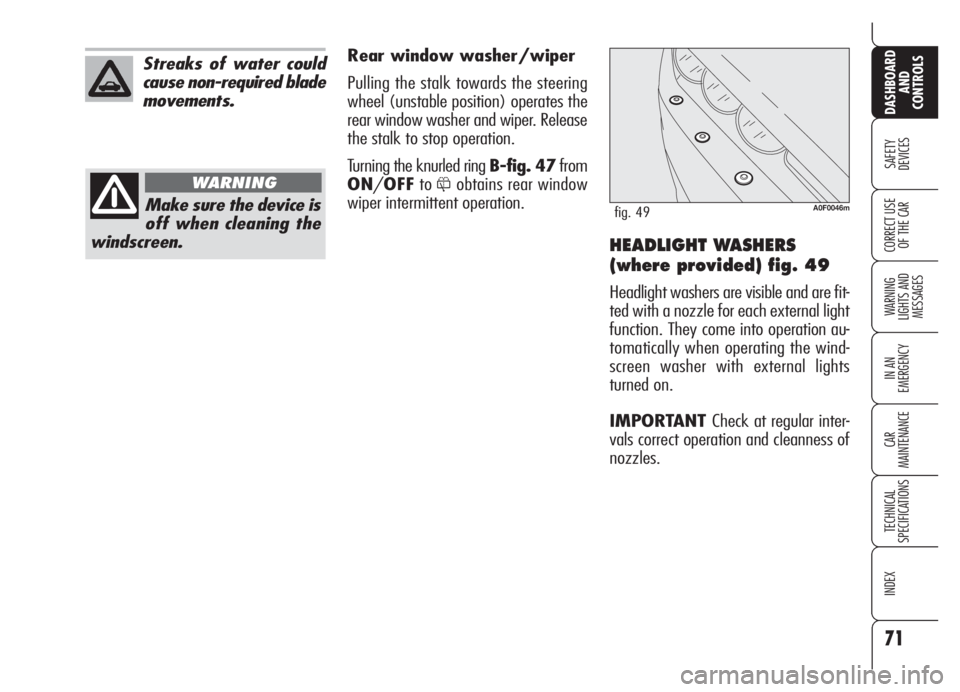
71
SAFETY
DEVICES
WARNING
LIGHTS AND
MESSAGES
IN AN
EMERGENCY
CAR
MAINTENANCE
TECHNICAL
SPECIFICATIONS
INDEX
DASHBOARD
AND
CONTROLS
CORRECT USE
OF THE CARHEADLIGHT WASHERS
(where provided) fig. 49
Headlight washers are visible and are fit-
ted with a nozzle for each external light
function. They come into operation au-
tomatically when operating the wind-
screen washer with external lights
turned on.
IMPORTANT Check at regular inter-
vals correct operation and cleanness of
nozzles.
Make sure the device is
off when cleaning the
windscreen.
WARNING
A0F0046mfig. 49
Streaks of water could
cause non-required blade
movements.Rear window washer/wiper
Pulling the stalk towards the steering
wheel (unstable position) operates the
rear window washer and wiper. Release
the stalk to stop operation.
Turning the knurled ring B-fig. 47from
ON/OFFto
&obtains rear window
wiper intermittent operation.
Page 73 of 270

72
SAFETY
DEVICES
WARNING
LIGHTS AND
MESSAGES
IN AN
EMERGENCY
CAR
MAINTENANCE
TECHNICAL
SPECIFICATIONS
INDEX
DASHBOARD
AND
CONTROLS
CORRECT USE
OF THE CAR
CRUISE CONTROL
(where provided)
GENERAL
The speed regulator (CRUISE CON-
TROL), with electronic control, makes
it possible to drive the car at the required
speed, without pressing the accelerator
pedal. This reduces driving fatigue dur-
ing long journeys (specially on high-
ways) because the speed memorised is
automatically maintained.
IMPORTANTThe device can only be
engaged at speeds between 40 and
190 km/h.
A0F0095mfig. 50
DEVICE ENGAGEMENT
Turn knurled ring A-fig. 50toÜ.
The device cannot be engaged in first
speed or reverse. It is recommended to
engage it in 4th or higher speeds. Trav-
elling downhill with the device engaged,
the car speed may increase more than
the memorised one.
When the device is activated the in-
strument panel warning light
Üturns
on (on certain versions together with a
message on the display) (see section
“Warning lights and messages”).
TO MEMORISE SPEED
Proceed as follows:
❒turn the knurled ring A-fig. 50
to
Üand press the accelerator ped-
al to the required speed;
❒push the stalk upwards (+) or down-
wards (–), then release it: car speed
is memorised and it is therefore pos-
sible to release the accelerator ped-
al.
In the case of need (when overtaking
for instance) acceleration is possible sim-
ply pressing the accelerator pedal: re-
leasing the accelerator pedal, the car will
return to the speed memorised previ-
ously.
Page 74 of 270
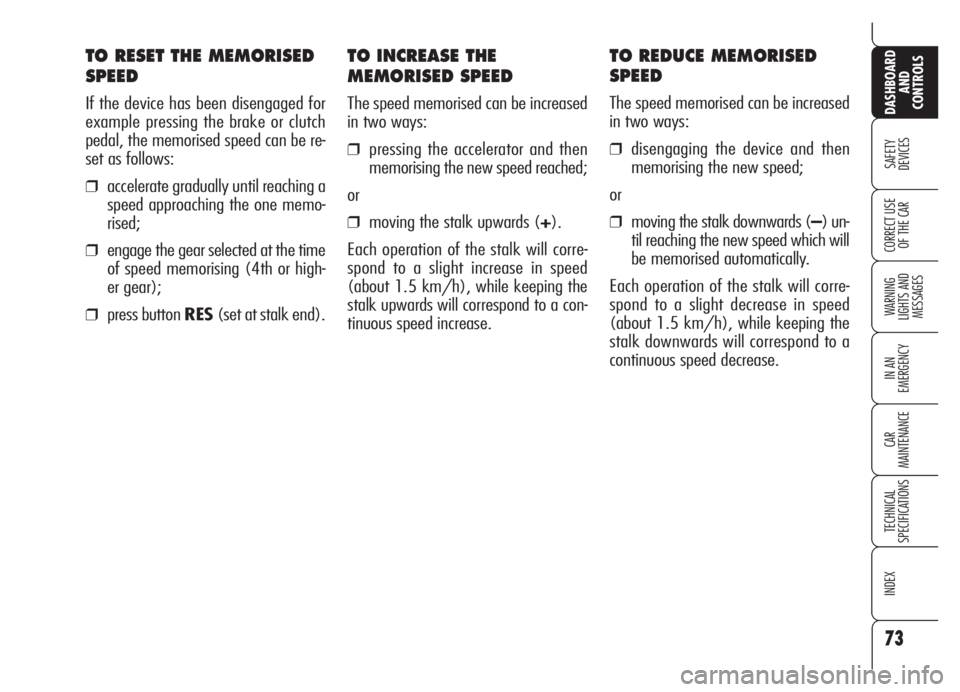
TO INCREASE THE
MEMORISED SPEED
The speed memorised can be increased
in two ways:
❒pressing the accelerator and then
memorising the new speed reached;
or
❒moving the stalk upwards (+).
Each operation of the stalk will corre-
spond to a slight increase in speed
(about 1.5 km/h), while keeping the
stalk upwards will correspond to a con-
tinuous speed increase.
TO REDUCE MEMORISED
SPEED
The speed memorised can be increased
in two ways:
❒disengaging the device and then
memorising the new speed;
or
❒moving the stalk downwards (–) un-
til reaching the new speed which will
be memorised automatically.
Each operation of the stalk will corre-
spond to a slight decrease in speed
(about 1.5 km/h), while keeping the
stalk downwards will correspond to a
continuous speed decrease.
TO RESET THE MEMORISED
SPEED
If the device has been disengaged for
example pressing the brake or clutch
pedal, the memorised speed can be re-
set as follows:
❒accelerate gradually until reaching a
speed approaching the one memo-
rised;
❒engage the gear selected at the time
of speed memorising (4th or high-
er gear);
❒press button RES(set at stalk end).
73
SAFETY
DEVICES
WARNING
LIGHTS AND
MESSAGES
IN AN
EMERGENCY
CAR
MAINTENANCE
TECHNICAL
SPECIFICATIONS
INDEX
DASHBOARD
AND
CONTROLS
CORRECT USE
OF THE CAR
Page 75 of 270
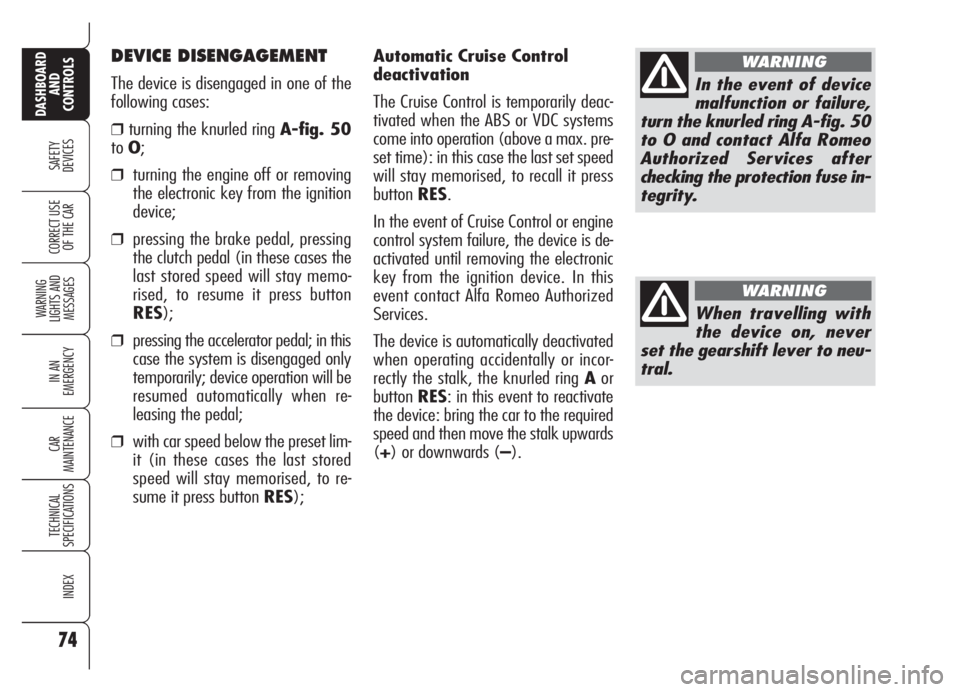
Automatic Cruise Control
deactivation
The Cruise Control is temporarily deac-
tivated when the ABS or VDC systems
come into operation (above a max. pre-
set time): in this case the last set speed
will stay memorised, to recall it press
buttonRES.
In the event of Cruise Control or engine
control system failure, the device is de-
activated until removing the electronic
key from the ignition device. In this
event contact Alfa Romeo Authorized
Services.
The device is automatically deactivated
when operating accidentally or incor-
rectly the stalk, the knurled ring Aor
buttonRES: in this event to reactivate
the device: bring the car to the required
speed and then move the stalk upwards
(+) or downwards (–).DEVICE DISENGAGEMENT
The device is disengaged in one of the
following cases:
❒turning the knurled ring A-fig. 50
toO;
❒turning the engine off or removing
the electronic key from the ignition
device;
❒pressing the brake pedal, pressing
the clutch pedal (in these cases the
last stored speed will stay memo-
rised, to resume it press button
RES);
❒pressing the accelerator pedal; in this
case the system is disengaged only
temporarily; device operation will be
resumed automatically when re-
leasing the pedal;
❒with car speed below the preset lim-
it (in these cases the last stored
speed will stay memorised, to re-
sume it press button RES);
74
SAFETY
DEVICES
WARNING
LIGHTS AND
MESSAGES
IN AN
EMERGENCY
CAR
MAINTENANCE
TECHNICAL
SPECIFICATIONS
INDEX
DASHBOARD
AND
CONTROLS
CORRECT USE
OF THE CAR
In the event of device
malfunction or failure,
turn the knurled ring A-fig. 50
to O and contact Alfa Romeo
Authorized Services after
checking the protection fuse in-
tegrity.
WARNING
When travelling with
the device on, never
set the gearshift lever to neu-
tral.
WARNING